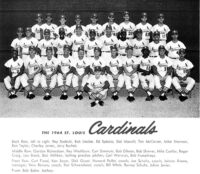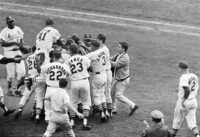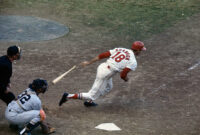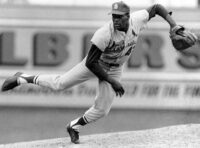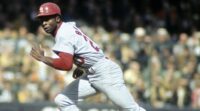Inductees
1964 St. Louis Cardinals
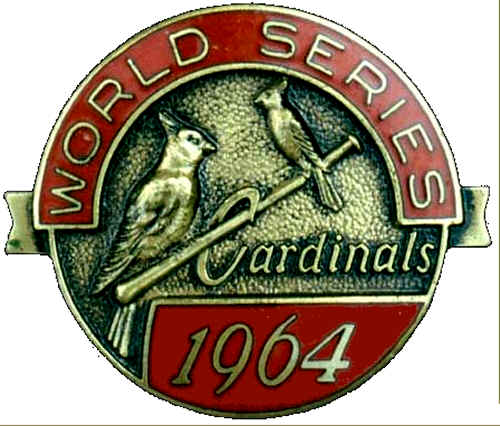
The 1964 St. Louis Cardinals went 93–69 during the season and finished first in the National League, edging the co-runners-up Cincinnati and Philadelphia by one game each on the last day of the regular season to claim their first pennant since 1946 and went on to beat the New York Yankees in seven games of the World Series.
And all this after the Cardinals rallied from 11 games back in the standings to win the NL pennant.
What a wild year it was.
In early weeks of the 1964 season, St. Louis hovered at the .500 mark. Cardinals GM Bing Devine, worried about both the team and his own job security, looked for a deal to make before the June 15 trading deadline.[
He consulted with manager Johnny Keane, and they decided that the team needed more speed. Keane and Devine focused on Lou Brock, an outfielder with the Chicago Cubs that the Cardinals had scouted years before and who had struggled since coming to the big leagues.
In June, with the trading deadline near and the Cardinals still around .500, Devine made the call to the Cubs and the deal was done.
On June 15, they traded star pitcher Ernie Broglio, who went 18–8 in 1963 and was having another good year in 1964, to the Cubs as part of a six-player deal for Brock. Many people thought the Cubs had gotten the better of the deal, including Chicago sportswriters and many Cardinal players.
However, Broglio would have a mediocre half-season for the Cubs and then two more ineffective, injury-riddled years in 1965 and 1966 before disappearing from the big leagues forever. Brock hit .348 for the 1964 Cardinals, and as a Cardinal went on to break the all-time record for stolen bases (since broken by Rickey Henderson) amass more than 3,000 base hits, and go into the Baseball Hall of Fame in 1985.
For most of the 1964 season, the Phillies looked like the team to beat. Philadelphia spent almost the entire first half in first or second place, and in July moved in first place seemingly to stay.
The Cardinals, on the other hand, spent much of the season mired in the middle of the pack, and sometimes close to the bottom. As late as June 17, the Cardinals were eighth in a 10-team league, although they were only six back of the lead. Brock joined the team and immediately began to hit, but St. Louis still could not dent Philadelphia’s lead.
The Cardinals called up prized prospect Mike Shannon in early July, and still they stagnated. They were seventh as late as July 24. One problem was first baseman Bill White, the Cardinal slugger and one of the few power hitters on the team, was bothered by a sore shoulder and struggling badly.
On August 16, with the Cardinals at 61–54 and 9 1⁄2 games out of first place, an impatient Gussie Busch fired Devine. Devine had been GM of the Cardinals since 1957,[11] but would not be around to see how the team he had built would finish. Busch considered firing Keane as well, but held back out of reluctance to further disrupt the team by firing both the manager and GM during the season.
Shortly thereafter, however, Busch met with Leo Durocher and made him a verbal offer to manage the Cardinals in 1965. Word soon got out that Keane was a lame duck.
On August 23, the Cardinals fell 11 games behind Philadelphia, tied for the farthest back they’d been all year, although they’d actually improved to fourth place in the overall standings. The Cardinals reeled off a six-game winning streak immediately after falling 11 back and continued to play well in September, but the Phillies seemed to be too far ahead to catch. On September 20, the Cardinals were tied with Cincinnati for second place, 6.5 games behind Philadelphia. A Sports Illustrated article described the Cardinal surge as “far too late.”
Injuries accumulated for the first-place Phillies as the season wore on. Slugger Frank Thomas broke his thumb. Starting pitcher Ray Culp hurt his elbow and had to go to the bullpen. Starting pitcher Art Mahaffey was slumping badly. Starting pitcher Dennis Bennett was plagued by tendinitis. Philly manager Gene Mauch, in a move that has remained controversial ever since, reacted to his rotation’s problems by using star pitchers Jim Bunning and Chris Short on less than normal rest six times down the stretch. Philadelphia lost all six of those games.
Still the Phillies held on to their lead. On September 20, Philadelphia was 90–60 and led the National League by 6 1⁄2 games with only 12 games to go. A pennant seemed assured. The Phillies even started taking applications for World Series tickets.
Then came the infamous “Phillie Phold.” The Phold started on September 21, when Philadelphia lost 1–0 to Cincinnati with the only run scoring on a steal of home. The Phils were swept in three games by Cincinnati, which crept to within 3 1⁄2 games of first place. Then they were swept in four games by Milwaukee. On the 25th, the Braves beat Philly in 12 innings. On the 26th, they beat Philly by scoring three in the top of the ninth. On the 27th, Milwaukee beat the Phils 14–8, extending their losing streak to seven games and dropping them out of first place for the first time in two months.
Philadelphia was one game behind Cincinnati, while the Cardinals, who’d gone 6–1 during Philadelphia’s streak, were in third place, 1.5 games back. The Phillies were feeling the pressure and making mistakes on the bases; in one 15-game stretch, 10 Phillies were thrown out trying to take an extra base.
St. Louis and Philadelphia met for a crucial three-game series starting in St. Louis on September 28. The Cardinals won the first game 5–1, vaulting past Philly into second place, one game behind the idle Reds, with the Phils 1.5 games back. On the 29th,, the Cards beat the Phils 4–2 behind a strong start from Sadecki, and Cincinnati lost to visiting Pittsburgh. The Cardinals were in first place for the first time all year, tied with the Reds, with Philly 1.5 games back. On the 30th, the Cardinals beat the Phillies again, 8–5, with Curt Simmons beating Bunning. Cincinnati lost to Pittsburgh at home again, and the Cardinals had sole possession of first place. Philadelphia had lost 10 in a row and the Cardinals had won eight in a row.
The Cardinals lost 1–0 on October 2 at home to the terrible Mets while the Phillies beat the Reds in Cincinnati to finally end their losing streak.
On the 3rd, the Cardinals lost again to the Mets while the Phillies and Reds remained idle. St. Louis and Cincinnati were tied for first place with 92–69 records, while Philadelphia was one game behind at 91–70. On the last day of the season, October 4, the Phillies beat the Reds at Cincinnati again, but the Cardinals beat the visiting Mets 11–5 to win the pennant by one game, with a 93–69 record; if the Cardinals had lost that game, the regular schedule would have ended in a 3-way tie for the pennant. The “Phold” is remembered as one of the worst late-season collapses in baseball history.
The Cardinals, having won their first pennant since 1946, would go on to face the mighty Yankees in the World Series.
1964 World Series
After another devastating loss in the previous year’s Classic, a different Yankees team returned to represent the American League in 1964. Yogi Berra had replaced Ralph Houk at the helm and under his guidance, the Yanks managed to barely win the American League pennant by a single game over the Chicago White Sox. It was the 15th World Series for the former Yankee catcher as Berra had first appeared in the contest in 1947 and went on play in a record seventy-five games before his last outing in 1963.
Many of his former teammates had remained in New York as Mickey Mantle prepared to play in his 12 postseason, Whitey Ford entered his 11th and Bobby Richardson posted his ninth appearance. Roger Maris, who was only in his fifth season as a Yankee, had never missed the World Series since donning the blue pinstripes.
Their opponents, the Cardinals had just missed the previous year’s contest by finishing six games behind the Los Angeles Dodgers (who had dethroned the once-mighty Yankees in a four game sweep) and were determined to follow suite.
Whitey Ford, always a postseason standout, held onto a 4-2 lead going into the sixth inning of the opener, but Shannon hammered a long two-run homer off the veteran lefty and, when catcher Tim McCarver followed with a double, the 35-year-old Ford was through for the day, and (because of arm problems) the Series.
The 9-5 loss of Game 1 as well as their #1 ace should have been a sign for what was to come as the Yanks were now experiencing a new kind of strea — a losing one. The opening fiasco was their fifth consecutive loss in World Series play and for the first time (in a long time) the Yankees were the underdogs.
In an attempt to jumpstart his team, Berra gave the Game 2 ball to an up-and-coming rookie named Mel Stottlemyre who went against Cardinal ace Bob Gibson. Stottlemyre had thrown strong down the home stretch (after getting called up from Richmond in August) and was a deciding factor for New York in the close American League pennant race. Both pitchers stood firm until Gibson left the game and his relief surrendered four ninth-inning runs for an 8-3 loss that put the “Bombers” back in the race.
Game 3 followed the same script as veteran Curt Simmons and the Yankees’ Jim Bouton were locked in a 1-1 tie through eight innings. Manager Johnny Keane used a pinch-hitter for Simmons in the ninth as the Cards threatened, but failed, to score. Barney Schultz, a clutch reliever for St. Louis, entered the game in the bottom of the ninth and threw one pitch, which Mantle promptly launched into the right-field stands for the 2-1 win.
Ray Sadecki started Game 4 against the Yanks Al Downing, but was taken for three quick first inning runs. Downing fared better and protected the lead going into the fifth, but the lefty was nailed by Ken Boyer for a grand-slam in the following inning. With relievers Roger Craig and Ron Taylor combining for 8 2/3 innings of two hit, scoreless relief, St. Louis went on to even the Series with a 4-3 victory.
Gibson returned for Game 5 and was one out away from a 2-0 victory when the Yanks’ Tom Tresh ripped a two-run homer that tied it up. Gibson prevailed however, after McCarver came up huge with a three-run blast off Yanks reliever Pete Mikkelsen for the 5-3 victory.
Game 6 witnessed yet another nail-biter as the game remained tied 1-1 going into the sixth. This time it was the Yankees coming up big with two consecutive home runs by Mantle and Maris and a grand slam by Joe Pepitone off reliever Gordon Richardson in the eighth. When it was over, New York had won 8-3 while staying alive and forcing a final Game 7.
Stottlemyre and Gibson both returned for the climatic finale and held each other scoreless through three innings. Then the Cardinals broke loose for three runs in the fourth and three more in the fifth, touched off by a home run by Lou Brock.
Brock proved to be a brilliant investment during the regular season after stealing 33 bases and batting .348 in one-hundred three games. Mantle responded with a three-run homer in the sixth, and Clete Boyer and Phil Linz both followed “The Mick’s” lead in the ninth. Despite their efforts, Gibson stood tall and finished the complete-game with a 7-5 Cardinal triumph.
The Boyer brothers had both come up big for their respective teams and set a record as the first set of brothers to hit home runs in the same Series. Ken had contributed two for St. Louis and Clete added one for New York (with one for each coming in the same game).
For the Cardinals, it was the end of a long postseason drought as they had not appeared in the Fall Classic since 1946.
For the Yankees, it was the end of an era as the perennial champions were about to start a drought of their own. Within two years, the American League dynasty would fall from first to last and it would be several years before returning to their former glory (12 years).
It was the last World Series appearance for many regulars including Mantle (who set the all-time Series home run record at 18), Ford, Richardson, Kubek and Boyer. Howard would appear in the Classic once more (with the Boston Red Sox) and Maris was destined to play in two more with the Cardinals.
Both managers were no longer at the helm after the Series (Berra was fired & Keane resigned), but in a strange twist, it would be the unemployed Cardinals skipper Johnny Keane who resurfaced in a Yankees uniform as Yogi Berra’s replacement.
